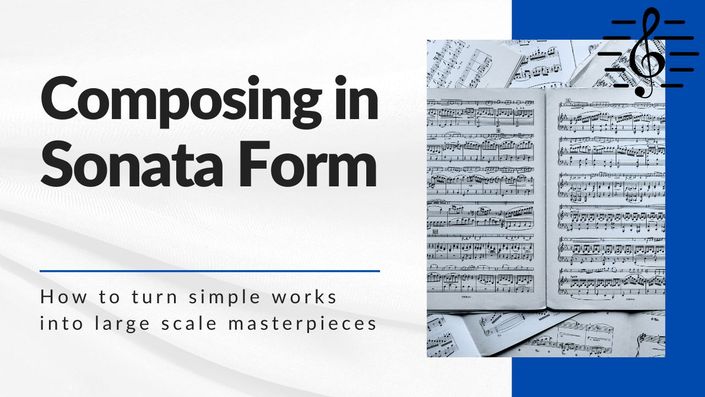
Composing in Sonata Form
Start writing extended pieces, develop material and learn how to compose music using Sonata Form.
Enroll in Course
What You Will Learn
Learn how to write and develop longer pieces with the Composing in Sonata Form course.
Sonata Form serves as the catalyst for honing your composition skills and nurturing your growth as a proficient music creator. This course begins with an explanation of Sonata Form - what it is and how it evolved during the Classical Period. We then analyse Sonata Form movements written by Mozart and Beethoven to discover how Classical Period composers wrote in this structure and in order to see how Sonata Form was to develop during the Romantic Period. The course also explains the possible variants within Sonata Form that composers might choose to explore. There follow two composition projects. In the first, we write the essentials of a Sonata Form movement in the Classical Period style, considering how to compose first and second subjects, how to develop and recapitulate material, when to include an introduction, a Coda and transition material. In the second, we write a more extended Sonata Form movement in a more contemporary style, learning to deal with the challenges of working with Sonata Form in an atonal environment. During the Composing in Sonata Form course we'll cover...
- Historic Background - What is Sonata Form? Why is it so important? How did Sonata Form originally develop?
- Sonata Form Analysis - How do you identify a piece of music using Sonata Form? How do you find the exposition, development and recapitulation sections? How do famous composers like Mozart and Beethoven write music in Sonata Form?
- Exposition - How do you compose a first and second subject that works? How might you write a suitable introduction? How do you create a smooth transition between subjects?
- Development - What techniques can you use to develop subject ideas? What do you need to think about in regards to key movement? What makes a good balance of existing themes and new material?
- Recapitulation - How do you craft a working recapitulation? What techniques can you employ to make subjects more interesting? Are there any possible alternative structures?
Wow!! What a wonderful, well thought out overview of the Sonata Form. I can't tell you how much I appreciate all the time and care you took to explain all of the components and why and how it developed. This is so useful, so important, and absolutely riveting. Already worth the price of admission!! Thank you so much.
- Paul

Who Is This Course For?
Composers who want to write strong themes and learn how to develop ideas into longer structures.
Many composers are great at coming up with musical ideas but feel less comfortable about developing and organising their ideas into a well defined musical structure. Many composers are great at writing short pieces but struggle to compose on a larger scale. Many composers know about Sonata Form but are unsure about how best to use it and about all the variants it offers. This course covers all that ground and places it in the context of the development of Sonata Form from the Classical Period to the present day. It’s a fabulous way to develop your compositional skill.
Do any of these sound familiar?
"I want to learn how to write strong thematic material..." "I want to deepen my understanding of how to write in Classical style..." "I can write short pieces but struggle to develop my ideas and turn them into longer movements…" "I'd like to learn how to compose in Sonata Form and find it useful to watch an expert compose movements so I can follow the process step by step..." "I want to be clear about all the possible variants a composer can use when writing in Sonata Form…"
↓
Well, I love music and composing... always have and I find the knowledge Gareth has and his ability to chat through music concepts, theory and analysing works of music brilliant. Many thanks to Music Matters.
- Adrian

By the end of the Composing in Sonata Form course you'll be able to…

Understand what Sonata Form is and the various ways in which the Sonata Form structure can be varied

Write strong thematic material, develop it and present it in varied ways

Write extended pieces in the Classical style and in a more contemporary style

Analyse movements written in Sonata Form with ease

Confidently compose works on a bigger scale than you could before

Create music with a better use of structure and form, including writing transition material, Codas and introductions
The courses offered by Music Matters are professionally presented and highly informative. Even those who initally profess to have only a slight interest in music theory and performance will find the courses highly stimulating and interesting. As somebody who has completed several of these courses, I cannot begin to put into words how grateful I am to the team at Music Matters for the knowledge I have gained, and the hours of enjoyment I have spent in studying their content.
- Tuss

Course Information
What's Included with the Composing in Sonata Form Course?
Professional Teaching
You'll receive expert teaching how to write in Sonata Form, bar by bar demonstrations, gradually building up to forming complete pieces with the correct structure.
Practical Exercises
Practical lessons demonstrate how to compose effectively in the Serial style with exercises designed to enable you to put into practise what has been covered.
Ask Questions
At any point during the course you are able to post comments and ask questions below each video should you have any in regards to the topics covered.
Easy to Follow Structure
The course is divided into multiple stages, breaking down each part separately before putting it all together.
Complete at Your Own Pace
You can easily fit the course around your regular commitments, completing it at your own pace and in your own time.
Anywhere Access
Your course never expires. Learn when and where you choose! Computer or mobile. Just get comfortable and dive in!
↓
Your Instructor

Hi, I’m Gareth and I'm passionate about developing ‘the all round musician’.
Over 35 years of music examining with ABRSM, work with the BBC on Radio and TV, experience on the international concert platform, as a published composer and arranger, have brought rich resources to the 40 years of teaching in which I've engaged.
Scholarships at The Royal College of Music, Oxford University and St. Paul’s Cathedral gave me fantastic opportunities to learn from the best musicians, scholars and teachers. Working as Director of Music at Queen Elizabeth Grammar School then provided a wonderful opportunity to develop my teaching skills.
Teaching individuals and groups of all ages, and at all stages of development have refined a teaching approach that I hope is fun and engaging, and focused on explaining things clearly and logically. And that is what these courses are all about - understanding the basic principles with clarity, then going deeper, applying them to your musical life and liberating yourself as a musician.
It’s a rich and amazing journey, and I can’t wait for you to join me today!
Course Curriculum
-
StartLesson 1 - What's the Big Deal about Sonata Form? (15:56)
-
PreviewLesson 2 - What is Sonata Form? (24:34)
-
StartLesson 3 - How Mozart Writes in Sonata Form in K.284 (45:09)
-
StartLesson 4 - What Does Beethoven Do Differently in Op.53? (44:12)
-
PreviewLesson 5 - Composing in Sonata Form Classical Style 1 (First Subject) (24:44)
-
StartLesson 6 - Composing in Sonata Form Classical Style 2 (Second Subject) (27:08)
-
StartLesson 7 - Composing in Sonata Form Classical Style 3 (Adding an Introduction) (17:07)
-
StartLesson 8 - Composing in Sonata Form Classical Style 4 (Adding a Transition Between Subjects) (14:08)
-
StartLesson 9 - Composing in Sonata Form Classical Style 5 (Adding a Codetta to Complete the Exposition) (13:24)
-
StartLesson 10 - Composing in Sonata Form Classical Style 6 (Adding an Additional Second Subject) (19:12)
-
StartLesson 11 - Composing in Sonata Form Classical Style 7 (Developing First Subject Ideas) (26:37)
-
StartLesson 12 - Composing in Sonata Form Classical Style 8 (Developing Second Subject Ideas) (12:06)
-
StartLesson 13 - Composing in Sonata Form Classical Style 9 (Possible Alternative Structures) (15:41)
-
StartLesson 14 - Composing in Sonata Form Atonally 1 (Designing First and Second Subjects) (27:20)
-
StartLesson 15 - Composing in Sonata Form Atonally 2 (Writing an Introduction) (31:09)
-
StartLesson 16 - Composing in Sonata Form Atonally 3 (First Subject Area) (43:29)
-
StartLesson 17 - Composing in Sonata Form Atonally 4 (Second Subject Area) (42:26)
-
StartLesson 18 - Composing in Sonata Form Atonally 5 (Development Section) (48:35)
-
StartLesson 19 - Composing in Sonata Form Atonally 6 (Recapitulation) (20:29)
-
StartLesson 20 - Composing in Sonata Form Atonally 7 (Coda) (13:32)
-
StartLesson 21 - Conclusion (6:51)
Frequently Asked Questions
A Letter from Gareth Green
MA (Oxon), MA (Leeds), FRCO(CHM), FLCM, ARCM
As we each make our musical journey, inevitably there are significant moments. Sometimes we feel as if we’re working hard but sense that we’re not making substantial progress. At other points in the journey there are light bulb moments that suddenly open new doors. One of those light bulb moments on my own musical journey concerns Sonata Form.
I remember as a junior student at the Royal College of Music in London starting to learn Piano Sonatas without having a grasp of what Sonata Form was. I could play the notes but had very little idea what was going on so I’m sure that there was much lacking in interpretation.
Alongside my piano and organ studies I was also taking lessons in composition. I could write short pieces but lacked the ability to develop material and to work in more extended structures.
One day, an analysis class was devoted to unpacking the structure of the first movement of Haydn’s Op.64 no.5 “Lark” quartet. Sonata Form was suddenly revealed to me. I was mesmerised by the idea that a composer could come up with two strong themes, one in the tonic key and one in the dominant key, and could then develop these ideas in so many imaginative ways before recapitulating the original themes in the tonic key. Not only was the Sonata Form structure a revelation but also the notion of how to develop ideas in terms of melody, rhythm, harmony and texture.
I returned to the Piano Sonatas with renewed enthusiasm and insight, and also set about writing my first composition in Sonata Form. Despite the many shortcomings that still existed, suddenly my 16 bar compositions were ten times the length. Furthermore, the compositions had a stronger sense of purpose instead of relying on repetition until the piece ran out of steam.
Looking back on it, I wish I had got to grips with Sonata Form sooner because it opened my mind to an absolutely central structure of the Classical and Romantic periods and beyond, and gave me confidence to perform and to compose music in more extended structures. My window into the whole new world of Sonata Form and beyond was explained as a theoretical and analytical concept and I was left to work out the practical detail for myself.
That’s why this course, besides covering the theoretical, the analytical, and the historical context, takes a very practical approach.
Come and join me as we study and write in Sonata Form together. My ambition is that it will empower you as it empowered me.
— Gareth Green, Music Matters




